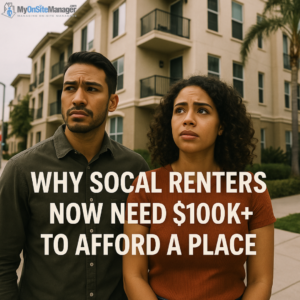Southern California has long been known for its sunny beaches, thriving entertainment industry, and diverse culture—but also its sky-high cost of living. Today, the dream of renting an apartment or home in SoCal is slipping further out of reach for many households. According to a recent Zillow analysis, renters in key Southern California cities now need an annual income well above $100,000 just to live comfortably.
This staggering figure highlights a growing issue: rent is rising far faster than wages, pushing millions of Americans into financial strain and making homeownership feel impossible.
1. The Widening Gap Between Rent and Income
Nationwide, rental costs have been increasing at unprecedented rates:
-
Apartments: Average monthly rent has jumped 28.7% since April 2020, reaching $1,858.
-
Single-Family Homes: Rent has surged even higher, climbing 42.9% to $2,256 per month.
At the same time, median household income has risen only 22.5%, now averaging about $82,000. That gap means many families are spending well above the recommended 30% of income on housing, often becoming “rent-burdened” or unable to save for emergencies and future goals like buying a home.
Five years ago, an income of around $60,000 was enough to rent comfortably in most U.S. cities. Today, the new benchmark is over $80,000—and in some places, even that’s not enough.
2. Southern California’s Six-Figure Renters
Zillow’s research reveals that three major SoCal metro areas now require six-figure salaries to comfortably afford rent:
-
Los Angeles – $118,958 annual income required.
-
Riverside – $102,722 annual income required.
-
San Diego – $122,810 annual income required.
This shift isn’t just about luxury apartments or beachside homes—even average units in these cities now demand six-figure earnings. Rising demand, limited housing supply, and the region’s desirability have all contributed to this crisis.
3. California vs. the Nation: A Steeper Climb
While Southern California’s rental market is among the toughest, it’s part of a nationwide trend. Eight major metro areas across the U.S. now require six-figure incomes for rent:
-
New York City – $144,960 (highest in the U.S.)
-
San Jose – $136,532
-
San Francisco – $124,267
-
Boston, Seattle, Miami, and Washington D.C. also rank high on the list.
In many ways, California renters are squeezed twice—by both high rental prices and some of the slowest wage growth compared to the cost of living.
4. The Impact on Renters and Families
What does this mean for the average family or young professional? For many, renting now consumes 40% or more of monthly income, leaving little for:
-
Savings and retirement funds
-
Emergency expenses like healthcare or car repairs
-
Education costs
-
Down payments for a future home
As Zillow senior economist Orphe Divounguy explains:
“Housing costs have surged since pre‑pandemic, with rents growing quite a bit faster than wages. This often leaves little room for other expenses, making it particularly difficult for those hoping to save for a down payment on a future home.”
This situation is forcing many to live with roommates, downsize to smaller spaces, or move further inland where rents are lower—but that often comes with longer commutes and fewer job opportunities.
5. Why Are Rents So High?
Several factors are driving these steep rent increases:
-
Housing Shortage: California has struggled to build enough affordable housing to keep up with demand.
-
Population Density: Major job hubs like Los Angeles and San Diego attract millions of workers and students.
-
Post-Pandemic Trends: As people returned to cities, demand soared faster than supply could adjust.
-
Inflation and Interest Rates: Higher mortgage rates have kept many renters from buying homes, further increasing rental demand.
6. What Can Renters Do?
While individual renters can’t control market forces, there are a few strategies to help navigate this challenging environment:
-
Explore Inland or Suburban Areas: Moving slightly away from the coast or urban hubs can offer significant rent savings.
-
Negotiate Lease Terms: Some landlords may offer incentives like a free month of rent for longer lease commitments.
-
Consider Co-Living or Shared Housing: Splitting rent with roommates can offset rising costs.
-
Stay Informed About Local Policies: Rent control or tenant protection laws may offer some relief in certain areas.
Conclusion: A Call for Solutions
The fact that renters now need $100,000 or more to live comfortably in Southern California is a wake-up call for policymakers, developers, and communities. Without significant investment in affordable housing and initiatives to close the wage-rent gap, millions will continue to struggle.
For now, renters must remain strategic, informed, and flexible in their housing choices. But long-term, solving California’s housing crisis will require systemic changes—from zoning reforms to more robust renter protections.
Source: Fox LA – These Southern California cities require six‑figure incomes to afford rent

